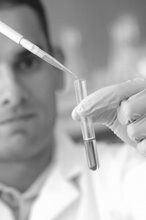In 1997 Dr. Stanley Prusiner of the University of California at San Fransisco was awarded the Nobel Prize in Medicine or Physiology for his discovery of prions approximately 15 years earlier. Prusiner had characterized the first infectious agents that were not somehow regulated by DNAs or RNAs.
Prions are proteinaceous infectious particles which cause diseases in myriad animals by affecting the structure and, subsequently, the function of the brain and other neural tissues. All are fatal. Prions are actually made of a protein which exists normally in healthy humans and animals called PrPc. The infectious, or PrPsc, form is different in that it is folded differently such that it cannot be broken down by proteases; the body's normal protein degrading enzymes. Not only is this aberrant form of PrP undegradable, it can actually transform the normal healthy PrP into the pathological form. It is worthwhile to note that while prion diseases can be infectious, some can be familial and directly inherited.
I like to think of the PrPsc protein as if it were an unruly elementary school student with very rich parents who have funded the new wing to the school. The bad student (PrPsc) should be expelled, but the administrators can't do it because they will lose necessary funding (proteases are unable to degrade PrPsc). As a result, the bad student is a terrible influence and converts formerly good students (PrPc) to his bad behavior. They all eventually burn down the school (Central Nervous System disease eventually resulting in death).
OK, so the analogy is crude, but you get the point, right?
A recent publication in PNAS, describes a simple but only recently possible approach to slowing this protein's infectious misbehavior. The researchers first analyzed the thermodynamic stability of PrPc. They found that the normal protein is most unstable at residues which cause a cavity in the protein. These sites of instability seem to be correlated with mutated regions of the PrP protein in inherited prion diseases.
The researchers then embarked on a "dynamics-based" drug discovery strategy. My impression of the strategy is that they utilized proteomic informatics technology to find chemical structures whi
 ch might bind to and stabilize the collapsible, unstable, residues of the healthy PrPc. If that isn't what they did, I think that might be a good idea...
ch might bind to and stabilize the collapsible, unstable, residues of the healthy PrPc. If that isn't what they did, I think that might be a good idea...The researchers eventually tested a handful of compounds in cell models and in animal models of prion diseases. They settled on one compound which did seem to stabilize the endogenous PrPc and reduced the rate of PrPsc induced degeneration in infected mice.
I have much interest in neurodegenerative protein conformation diseases because I work in amyotrophic lateral sclerosis (ALS) drug discovery. I have developed a bias where I am under the impression that the main key to unlocking neurodegenerative diseases lies in understanding the truth about protein misfolding, degradation, and aggregation and as such I find this publication to be very interesting. I may carry this bias as a result of having been heavily influenced by Dr. Susan Lindquist when my research group met with her about 4 years ago.
Dr. Lindquist is a leading protein misfolding expert and sums my feelings up best in the quote below:
- "What do "mad cows", people with neurodegenerative diseases, and an unusual type of inheritance in yeast have in common? They are all experiencing the consequences of misfolded proteins. ... In humans the consequences can be deadly, leading to such devastating illnesses as Alzheimer's Disease. In one case, the misfolded protein is not only deadly to the unfortunate individual in which it has appeared, but it can apparently be passed from one individual to another under special circumstances - producing infectious neurodegenerative diseases such as mad-cow disease in cattle and Creutzfeld-Jacob Disease in humans."
- --from "From Mad Cows to 'Psi-chotic' Yeast: A New Paradigm in Genetics," NAS Distinguished Leaders in Science Lecture Series, 10 November 1999.





No comments:
Post a Comment